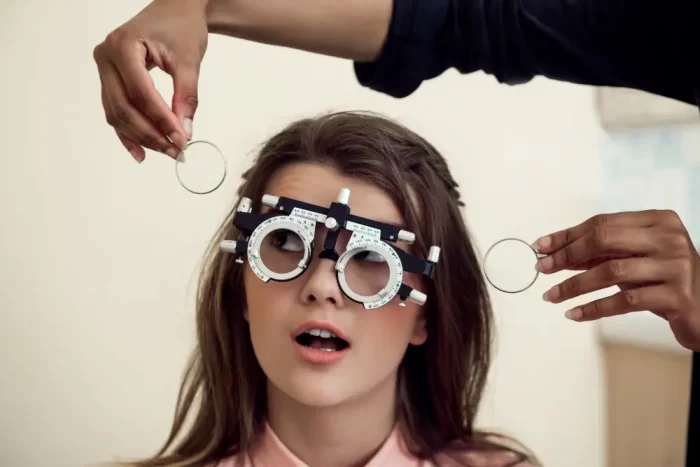Your eyes are your windows to the world. They help you see the beauty around you, recognize faces, and read the fine print on important documents. That’s why it’s vital to take care of your eyes at every stage of life.

This ultimate guide to eye care covers everything from infancy to old age, providing practical tips, important facts, and expert insights to keep your vision sharp and healthy.
Early Eye Care: From Infancy to Early Childhood
Developmental Milestones and Eye Health
Eye development in infants is rapid. By the age of three months, babies can focus on objects and track them with their eyes. By six months, they develop depth perception and better hand-eye coordination. Monitoring these milestones is crucial for ensuring healthy eye development.
Parents should be vigilant about their child’s eye health, even if there are no apparent issues. Pediatricians recommend that infants receive their first comprehensive eye exam at six months. Early detection of problems can prevent long-term vision issues.
Signs of Eye Problems in Children
It’s essential to watch for signs of eye problems in young children. Common indicators include excessive tearing, frequent eye rubbing, sensitivity to light, and poor visual tracking. If you notice any of these signs, consult an eye care professional promptly.
Additionally, squinting, tilting the head, or holding objects very close to the face can signal vision problems. Early intervention can improve outcomes significantly, so never ignore these signs.
Recommended Screen Time and Eye Safety
In today’s digital age, even young children are exposed to screens. The American Academy of Pediatrics suggests limiting screen time to no more than one hour per day for children aged two to five. Excessive screen time can lead to digital eye strain and other vision problems.
Encourage outdoor play and activities that promote eye development. Ensure that children use protective eyewear during sports and outdoor activities to prevent injuries.
Eye Care for School-Age Children
Importance of Regular Eye Exams
School-age children need regular eye exams to catch any vision problems early. About 5-10% of preschoolers and 25% of school-aged children have vision issues, which can impact learning and development. Annual eye exams can help identify conditions like nearsightedness, farsightedness, and astigmatism.
Eye exams also allow for the detection of more serious issues such as amblyopia (lazy eye) and strabismus (crossed eyes). Early treatment is crucial for these conditions.
Common Eye Conditions in Children
Children can experience a range of eye conditions. Nearsightedness (myopia) is common and usually appears between ages 6 and 14. Farsightedness (hyperopia) and astigmatism can also affect children’s vision.
Vision therapy or corrective lenses may be recommended to address these issues. Regular follow-ups ensure that the treatment is effective and adjustments are made as needed.
Tips for Protecting Eyes at School and Home
Encourage children to take regular breaks from reading and screen time to reduce eye strain. The 20-20-20 rule—looking at something 20 feet away for 20 seconds every 20 minutes—can be very helpful.
Ensure good lighting when reading or doing homework to prevent eye fatigue. Educate children on the importance of not rubbing their eyes and washing hands regularly to avoid infections.
Eye Care for Teens and Young Adults
Digital Eye Strain and Blue Light
Teens and young adults spend a significant amount of time on digital devices, which can cause digital eye strain. Symptoms include dry eyes, headaches, and blurred vision. Using blue light filters and taking regular breaks can mitigate these effects.
Educate young adults about the impact of prolonged screen time on their vision. Encourage them to use proper posture and adequate lighting when using digital devices.
Contact Lens Safety and Hygiene
Contact lenses are popular among teens and young adults. However, improper use and hygiene can lead to serious eye infections. Always follow the eye care professional’s instructions for cleaning and storing contact lenses.
Never sleep in contact lenses unless prescribed. Always wash hands before handling lenses and use the appropriate solution for cleaning.
Vision Changes and Corrective Options
Vision changes can occur during adolescence and young adulthood. Regular eye exams help monitor these changes and update prescriptions as needed. Corrective options like glasses, contact lenses, or even refractive surgeries such as LASIK can be explored.
Discuss options with an eye care professional to determine the best solution for your vision needs. Technologies like Zeiss SMILE surgery offer minimally invasive corrective options worth considering.
Adult Eye Care: Maintaining Healthy Vision
Common Age-Related Eye Conditions
Adults are susceptible to age-related eye conditions such as presbyopia (difficulty focusing on close objects), cataracts (clouding of the eye lens), and glaucoma (increased eye pressure leading to optic nerve damage). Regular eye exams can detect these conditions early.
Early detection and treatment can prevent severe vision loss and maintain quality of life. Consult your eye care professional about any changes in vision.
Lifestyle and Diet for Healthy Eyes
A healthy lifestyle and diet can significantly impact eye health. Foods rich in omega-3 fatty acids, vitamins C and E, and zinc can help prevent age-related vision problems like macular degeneration.
Avoid smoking and excessive alcohol consumption, as they can negatively affect eye health. Regular exercise and maintaining a healthy weight also contribute to overall eye health.
The Importance of Regular Eye Exams
Regular eye exams are crucial for maintaining healthy vision. Adults should have a comprehensive eye exam every two years, or more frequently if they have existing vision problems or risk factors like diabetes.
Eye exams can detect not only vision issues but also systemic conditions like diabetes and hypertension. Early intervention can prevent complications and preserve vision.
Senior Eye Care: Protecting Vision in Later Years
Eye Health Concerns in the Elderly
Seniors face unique eye health challenges, including macular degeneration, diabetic retinopathy, and cataracts. These conditions can lead to significant vision loss if not managed properly.
Regular eye exams and prompt treatment are essential to managing these conditions. Seniors should also be aware of the symptoms of these conditions and seek medical advice if they notice changes in vision.
Vision Loss and Independence
Vision loss can impact a senior’s independence and quality of life. Simple modifications, such as better lighting and magnifying devices, can help seniors manage vision loss.
Support from family and community services can also enhance independence. Encourage seniors to stay active and engaged in activities they enjoy to maintain their quality of life.
Support Services and Technologies for the Visually Impaired
Various support services and technologies are available for seniors with vision impairment. Vision rehabilitation services can provide training and resources to help seniors adapt to vision loss.
Assistive technologies, such as screen readers and magnifying devices, can enhance daily living. Encourage seniors to explore these options to maintain independence.
Conclusion
Taking care of your eyes at every stage of life is essential for maintaining good vision and overall quality of life. Regular eye exams, a healthy lifestyle, and proper eye care habits can help protect your vision.
Encourage your loved ones to prioritize eye health and seek professional advice when needed. For more information on maintaining healthy vision, consult an eye care professional or visit reputable resources online.







